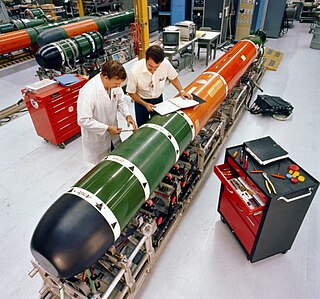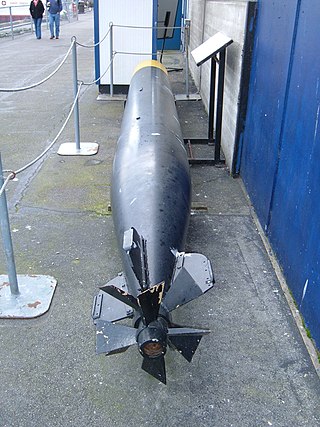Related Research Articles

A modern torpedo is an underwater ranged weapon launched above or below the water surface, self-propelled towards a target, and with an explosive warhead designed to detonate either on contact with or in proximity to the target. Historically, such a device was called an automotive, automobile, locomotive, or fish torpedo; colloquially a fish. The term torpedo originally applied to a variety of devices, most of which would today be called mines. From about 1900, torpedo has been used strictly to designate a self-propelled underwater explosive device.

The Tang-class submarines were the first submarines designed and built by the United States Navy after World War II. They incorporated the best features of the high-speed German Type XXI U-boat and the venerable U.S. Navy fleet submarine. The Tang class, with the fleet submarines converted under the Greater Underwater Propulsion Power (GUPPY) program, had much higher submerged performance than their predecessors, but were quickly surpassed by the nuclear-propelled submarines that entered service beginning in 1954. Six units in total were built.

The Mark 48 and its improved Advanced Capability (ADCAP) variant are American heavyweight submarine-launched torpedoes. They were designed to sink deep-diving nuclear-powered submarines and high-performance surface ships.

USS Torsk, hull number SS-423, is a Tench-class submarine built for the United States Navy during World War II. Armed with ten torpedo tubes, the Tench-class submarines were incremental developments of the highly-successful Gato-class submarines that formed the backbone of the US Navy's submarine force during the war. Torsk was laid down at the Portsmouth Navy Yard in June 1944, was launched in September that year, and commissioned in December.

The SEAL Delivery Vehicle (SDV) is a crewed submersible and a type of swimmer delivery vehicle used to deliver United States Navy SEALs and their equipment for special operations missions. It is operated by SEAL Delivery Vehicle Teams.

The United States' S-class submarines, often simply called S-boats, were the first class of submarines with a significant number built to United States Navy designs. They made up the bulk of the USN submarine service in the interwar years and could be found in every theater of operations. While not considered fleet submarines, they were the first submarines in the USN designed for open ocean, blue water operations. All previous submarines had been intended for harbor or coastal defense. These boats were intended to have greater speed and range than previous classes, with improved habitability and greater armament.

The MU90 Impact is a Franco-Italian advanced lightweight anti-submarine torpedo of the third generation developed for the French and Italian navies, as well as for export. It is designed to outperform the United States-built Mark 54 in and was developed in a special MU90 Hard Kill version for anti-torpedo defence. It is built by EuroTorp, a consortium of French and Italian companies.

The Mark 54 lightweight torpedo is a standard 12.75-inch (324 mm) anti-submarine warfare (ASW) torpedo used by the United States Navy.

The Mark 44 torpedo is a now-obsolete air-launched and ship-launched lightweight torpedo manufactured in the United States, and under licence in Canada, France, Italy, Japan and the United Kingdom, with 10,500 being produced for U.S. service. It was superseded by the Mark 46 torpedo, beginning in the late 1960s. The Royal Australian Navy, however, continued to use it alongside its successor for a number of years, because the Mark 44 was thought to have superior performance in certain shallow-water conditions.
The G7e torpedo was the standard electric torpedo used by the German Kriegsmarine submarines in World War II. It came in 20 different versions, with the initial model G7e(TII) in service at the outbreak of the war. Due to several problems, leading to the German "Torpedokrise" which lasted until the end of 1941, the improved G7e(TIII) took over as the standard electric torpedo used by German U-boats for the rest of the war. G7e torpedoes measured 533.4 mm (21.00 in) in diameter and about 7.2 m (24 ft) in length. Depending on the type, the warhead contained a main charge of 250–280 kg (550–620 lb) of Schießwolle 36, a mixture of dipicrylamine and TNT. All were powered by 60–72 kW (80–100 hp) electric motors and lead-acid batteries which required onboard maintenance to maintain their functionality.

The Mark 24 mine is an air-dropped anti-submarine (ASW) acoustic torpedo developed by the United States during World War II; it was called a mine to conceal its capabilities. The torpedo entered service with the Allies in March 1943; the United States Navy (USN) used it until 1948. Approximately 4,000 were produced. Of the 340 deployed during the war, 204 were fired, sinking 37 and damaging 18 Axis submarines.

The Mark 37 torpedo is a torpedo with electrical propulsion, developed for the US Navy after World War II. It entered service with the US Navy in the early 1950s, with over 3,300 produced. It was phased out of service with the US Navy during the 1970s, and the stockpiles were sold to foreign navies.

The Mark 14 torpedo was the United States Navy's standard submarine-launched anti-ship torpedo of World War II. This weapon was plagued with many problems which crippled its performance early in the war. It was supplemented by the Mark 18 electric torpedo in the last two years of the war. From December 1941 to November 1943 the Mark 14 and the destroyer-launched Mark 15 torpedo had numerous technical problems that took almost two years to fix. After the fixes, the Mark 14 played a major role in the devastating blow U.S. Navy submarines dealt to the Japanese naval and merchant marine forces during the Pacific War.

The Mark 18 torpedo was an electric torpedo used by the United States Navy during World War II. The Mark 18 was the first electric storage battery torpedo manufactured for the US Navy and it was designed primarily for use as a submarine-launched torpedo.
There have been a number of 18-inch (45cm) torpedoes in service with the Royal Navy of the United Kingdom.
There have been a number of 21-inch (53.3cm) torpedoes in service with the Royal Navy of the United Kingdom.
The Mark 21 torpedo, designated Mark 21 Mod 0 was a passive acoustic homing torpedo designed in 1943 by Westinghouse Electric Corporation. The Mark 21 successfully passed launching tests in 1943, however, due to difficulties encountered by Westinghouse, the project was abandoned after a few development models had been built.
The Mark 26 torpedo was a submarine-launched anti-surface ship torpedo designed by Westinghouse Electric in 1944 as an improved version of the Mark 28 torpedo.
The Mark 29 torpedo was a submarine-launched, acoustic torpedo designed by Westinghouse Electric in 1945 for the United States Navy. It used the same acoustic system as the Mark 28 torpedo but was faster, operated at various depths, had an external depth setter, and could run as either a straight or a homing torpedo. The Mod 1 variant had two speeds, a remote-setting variable enabler and an anti-circular run device.
The Mark 31 torpedo was a destroyer-launched acoustic torpedo developed by the Harvard and Pennsylvania State universities during World War II. A modification of the Mark 18 electric torpedo, it was conceived as an interim weapon to be used in the Pacific War until a new high-speed acoustic torpedo could be developed for the United States Navy.